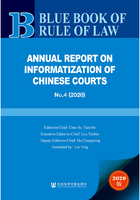
II Systematization of Court Informatization
General Secretary Xi Jinping noted that we should strengthen the construction of information infrastructure,reinforce deep integration of information resources,and create the information “arteries” of economic and social development.[2] On this basis,the Supreme People’s Court has responded actively to demand and committed itself to solving the problems of duplicate construction,overlapping functions and information “silos” that arose in the past,and proposed to build an all-factor integrated information infrastructure supported by cloud computing,aiming at strengthening system integration. The informatization of the Chinese courts is not informatization of a certain field or aspect of the people’s courts,but comprehensive informatization of trial and enforcement and its own administration. The construction is based on the systemic project of serving trial and enforcement,the people,its own administration,and governance of the country,so the Chinese courts have attached great importance to systematic promotion from beginning to end.
Leading Group Office on Internet Security and Informatization of the Supreme People’s Court has comprehensively summed up the current status of the SPC’s current information system construction,and formulated an overall design plan focusing on system integration and intelligent construction to guide the integrating and upgrading of current information systems. In 2019,the Supreme People’s Court adopted the General Guideline on Comprehensively Promoting Judicial Artificial Intelligence,the Evaluation Index System for Smart Court Construction (2019 Edition) and 14 People’s Court Informatization Standards[3],so as to guide the construction of online integrated preservation applications,applications for litigation-related petitions,mobile micro-court platforms,electronic litigation file cataloging and other informatization application systems,and judicial blockchain construction in courts across the country.
In the early stages of construction,the Chinese courts at all levels carried out technical framework design and program validation from the overall perspective,so as to ensure integrated construction of smart courts. During the process,the courts at all levels have worked hard to enhance the allocation of information infrastructures,build an intensive information network system,and share information between networks through security isolation and information exchange technology. They have continued to promote interdepartmental information interconnection,comprehensively improved the informatization of offices for handling public affairs and cases,such as litigation service centers,enforcement command centers and technology-enabled courtrooms. Efforts have also been made to strengthen system resource integration and sharing,and to promote interface integration,data integration and process integration.
With regard to the core work of trial and enforcement,they have coordinated integration of intelligent cloud networks by expanding the scope of intelligent cloud services for courts nationwide. “The People’s Court Intelligent Cloud Platform” has met the demand for multiple resource pools for a variety of application scenarios,and carried out unified management of multi-cloud environments. With the artificial intelligence applications such as text recognition,voice interaction and machine translation,the Cloud Platform has allowed the unified control and management of the traditional infrastructure on the cloud platform. “The People’s Court Intelligent Voice Cloud Platform” realized model sharing and centralized training of intelligent voice platforms in courts across the country,enabling an average increase of 1.5% in transcription accuracy in Mandarin Chinese. Besides,the Platform included model support for no less than three dialects and minority languages,and launched a pilot project for connection of heterogeneous voice platforms. The “Intelligent Cloud Network” has upgraded the People’s Court’s first-level intranets from a star structure to a ring structure,while tripling the access bandwidth of 32 high courts. Furthermore it has built a ring backbone network that supports integration of cloud and networks and distributed deployment of smart applications,thus ensuring high reliability of the backbone network of the People’s Courts’ data center. New network services such as domain name resolution and streaming media distribution have also been added.
Archives are the carrier of judicial work as well as the basis for judicial supervision and administration. In 2019,the Information Center of the Supreme People’s Court promoted the online electronic file system of four levels of courts to effectively manage litigation files and non-litigation files. The Supreme People’s Court has aggregated and managed non-litigation files (electronic public documents) at its level and possessed the ability to aggregate litigation files across the country. By opening up the technical channel for filing electronic official documents of the Supreme People’s Court at the top level,the Court is able to file documents with “one click” from the office platforms,big data platforms,file systems and electronic file systems of the four levels of courts. In addition,the newly developed function of submitting electronic files enabled 400 courts without file systems to collect archives by means of submitting.
In local courts at all levels,system integration and data sharing also represent the general trend. The Shanghai High People’s Court has joined hands with the High People’s Courts of Jiangsu Province,Zhejiang Province and Anhui Province in building the “Information and Data Resource Sharing Platform for Smart Courts in Yangtze River Delta”,jointly promoted the Information and Data Resource Sharing Platform in that region and cross-regional case docketing. The sub-platform for judges first shared seven main items,26 types of data,covering information on major cases,implementation of joint collaboration,judicial services,and application of law. The sub-platform for litigation services,relying on the national government services platform,was integrated in “access via one website” in the Yangtze River Delta. The first batch of services included payment of litigation fees,online case filing,smart case investigation,document delivery,contact with judges,and material submission. In addition,the mediation platform was set up to get connected with various industries and entities. The linking up of mediation resources of various industries with court trial resources helped with rational utilization of human resources. The three case filing service channels of litigation service network,mobile micro-courts and self-service case-filing equipment have realized data integration and connection between intranets and extranets,thus greatly helping the parties to handle relevant litigation business. Moreover,in solving “difficulties in delivery”,a number of courts have already provided centralized delivery,taking themselves to the forefront of information-based delivery with the help of big data.